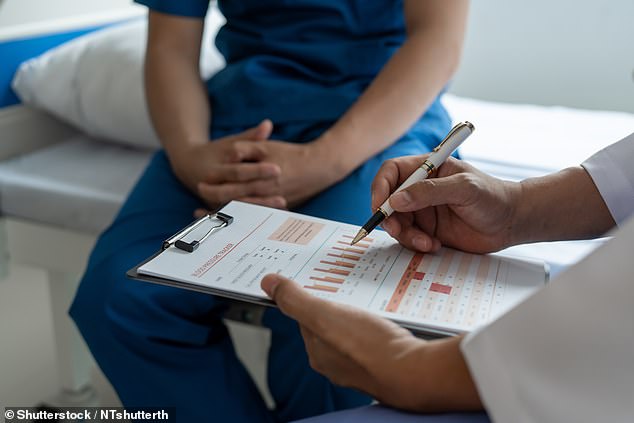British cycling legend Sir Chris Hoy has revealed that he has incurable prostate cancer and could have “two to four years to live”, at the age of just 48.
The 11-time Olympic gold medalist said in February that he was receiving treatment for cancer, but did not say what type of disease he had.
Fans were shocked today when he admitted his bleak prognosis, as the cancer had spread.
While prostate cancer is typically diagnosed in men over 70, there have been dramatic increases in the disease in patients under 50 since the early 1990s.
It’s not entirely clear why, as most prostate cancer is not clearly linked to lifestyle factors like obesity, like other cancers, but there are signs that men of all ages should be aware of.
British cycling legend Sir Chris Hoy has revealed that he has incurable prostate cancer and could have “two to four years to live”, at the age of just 48.

Fans were shocked when Sir Chris admitted his grim prognosis, due to the fact that the cancer had spread.
Mystery about the causes of early-onset prostate cancer
There are approximately 55,000 new cases of prostate cancer each year in the UK and the highest rate is in men aged 70 to 74.
It is the most common male cancer and more than 12,000 die from the disease annually.
There has been a more than 50 percent increase in diagnoses overall since 1990, but the largest increases have been in younger men.
Prostate cancer diagnosed before age 55 is sometimes called “young onset.”
Doctors aren’t sure why, although demographic changes in the UK (black men have twice the risk of prostate cancer compared to other ethnicities) may play a role.
Black men who have a direct relative, such as a father or brother, with prostate cancer have a four-fold increased risk.
The increase could also be due to better awareness, testing and diagnosis.
While there are some indications that factors such as obesity, lack of physical activity, and exposure to infections may increase risk, more research is needed.
What is the difference between early onset prostate cancer?
Sir Chris Hoy, 48, started chemotherapy earlier this year and has now revealed that his cancer is sadly advanced.
This means that it has spread beyond the prostate and throughout the body, making it very unlikely that it can be cured.
He has also said that he could only have two years to live.
Prostate cancer, if detected early, is highly treatable. Overall, nine out of ten men with the disease will survive five years or more, and eight out of ten survive for ten years.
The outlook is much less good for advanced prostate cancer, with survival reduced to one to three years.
Prostate cancer in younger men is more likely to be diagnosed at this stage, leading experts to believe it is a more aggressive type.
The easy-to-dismiss symptoms that no man should ignore
Because prostate cancer, like other cancers, is best treated in earlier stages, experts say all adult men should be aware of changes that could be a sign of the disease.
The prostate is a walnut-sized gland, located just below the bladder in men. It plays a vital role in semen production and ejaculation.
Due to its location, it most commonly causes urinary symptoms. If a man notices them, it is important to speak to a GP and discuss whether something called a PSA test might be warranted.
PSA stands for prostate-specific antigen, a hormone that the prostate produces in greater quantities if there is a problem with the gland.
One of the most common signs that something is wrong with the prostate is a change in urinary frequency.
While people’s urine output can vary widely (four to ten times can be considered normal), it’s a notable increase that experts say men should be aware of.
Sudden urges (the need to run to the bathroom) can also be a sign of a problem.
This could be accompanied by difficulty starting to urinate, which is medically known as hesitancy.
Effort or delay in emptying the bladder, a weaker than normal flow, and the feeling that the bladder has not been completely emptied are also symptoms.
A doctor should also promptly check for blood in urine or semen.
These symptoms do not always mean that a man has prostate cancer; More often than not, it could simply be a sign of benign prostate problems that affect more than half of men.
Signs of advanced cancer that may have spread include bone and back pain, loss of appetite and unexpected weight loss, and pain in the testicles.
What should you do if you are worried
The NHS states that any man over 50 can request a PSA test from their GP regardless of symptoms.
A PSA test alone cannot diagnose prostate cancer: sexual activity, vigorous exercise, certain medications, urinary tract infections, and benign enlargement of the prostate, all of which are very common, can increase PSA.
However, along with symptoms, it may warrant a prostate exam and possibly further testing.
For more information on prostate health visit Prostate cancer UK.
If a younger man suffers from any of the symptoms mentioned above, it might be worth having a PSA test and prostate exam.

The NHS states that any man over 50 can request a PSA test from their GP regardless of symptoms.
Liverpool-based prostate surgeon Marc Lucky said: ‘Any man concerned about his prostate aged 45 and over should be offered a PSA test.
“It’s important to discuss changes in urinary patterns with your doctor, as well as any other concerns.”
PSA testing is also available from private doctors and home tests are available from pharmacists, costing as little as £30.
“If a younger man gets an abnormal result, he may need to be referred to an experienced urologist who can perform an exam and other tests,” Mr. Lucky adds.

